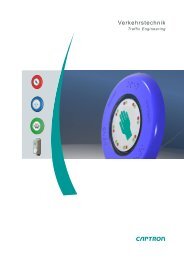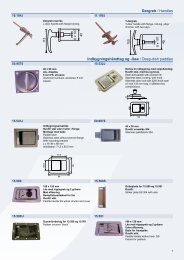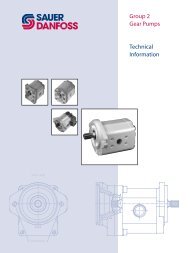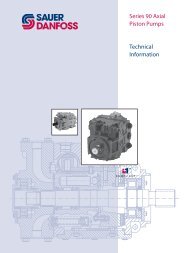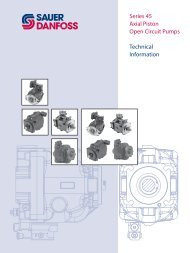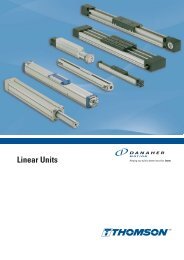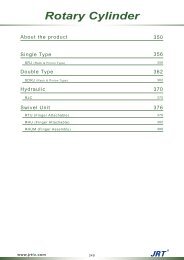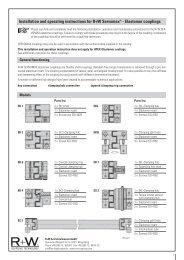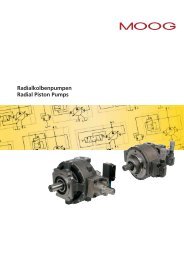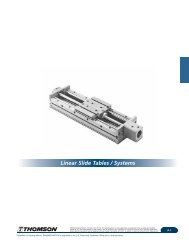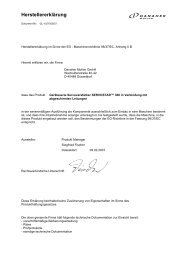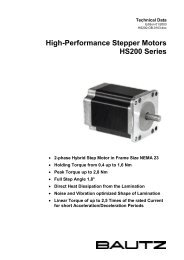You also want an ePaper? Increase the reach of your titles
YUMPU automatically turns print PDFs into web optimized ePapers that Google loves.
Definitions (Continued)<br />
1.37.2 THERMAL RESISTANCE (FRAME TO AIR): This is the same<br />
as 1.37.1 except that the temperature difference is between the<br />
winding and the surface of the motion O.D. midpoint and the air<br />
surrounding the motor. The air shall be still, the motor suspended<br />
in the air to prevent heat sink effect of bench surfaces, etc.<br />
1.37.3 THERMAL RESISTANCE (FRAME TO HEAT SINK): This is<br />
the same as 1.37.1 except that the temperature differential is that<br />
which exists between motor frame and a heat sink. The heat sink<br />
shall be sufficiently large and sufficiently thick to be (effectively) an<br />
“infinite heat sink” to the motor in question.<br />
1.38 THERMAL TIME CONSTANT: This is the time required for the<br />
winding temperature of a motor to reach 63% of its steady state<br />
temperature RISE with constant POWER applied to the motor. It is<br />
measured by allowing the motor to reach steady state temperature, and<br />
then disconnecting the electrical power input. The winding temperature is<br />
recorded as a function of time, zero time being the time at which the<br />
power source was disconnected. The time required to drop to 37% of the<br />
steady state temperature rise is the thermal time constant. It is usually<br />
expressed in seconds, but any unit of time may be used.<br />
1.39 TORQUE GRADIENT: Torque gradient (sometimes called “stiffness<br />
torque”) is the slope of the torque displacement curve at the no-load<br />
quiescent point.<br />
1.40 TRANSLATOR LOGIC: Translator logic translates the input pulse<br />
train into the selected mode pattern to be applied to a <strong>step</strong> motor.<br />
1.41 WINDING: A winding is an aggregate of magnet wire turns all on the<br />
poles of a given phase. Where there are two windings per phase, they may<br />
be connected in series or parallel. In the case of the series connection, the<br />
connection between the two windings of a phase (5-lead or 6-lead <strong>motors</strong>),<br />
the motor is referred to as a bifilar wound motor, but a “winding” consists<br />
of the magnet wire turns from the center tap to either end and not end to<br />
end.<br />
1.42 WINDING INDUCTANCE: The winding inductance of a <strong>step</strong> motor<br />
winding varies both with rotor position and with excitation current.<br />
Measurements can also be affected by the rate of change of current; thus<br />
when a figure for inductance is given, the conditions under which the<br />
measurements were taken must be quoted. The following three types of<br />
inductance measurements each have their advantage and disadvantage.<br />
That of 1.42.1 is the simplest and fastest measurement to make, and<br />
requires the least equipment, but is least representative of actual operation<br />
conditions. The method of 1.42.3 on the other hand is the most<br />
representative of actual operating conditions, but is the most difficult and<br />
time-consuming of the methods and requires the most specialized<br />
equipment. The method of 1.42.2 is a compromise, perhaps leaning<br />
towards 1.42.3 as being representative of actual operating conditions.<br />
STEP MOTORS<br />
1.42.1 INCREMENTAL UNENERGIZED WINDING INDUCTANCE:<br />
An inductance bridge having a test frequency of 1 kHz is used for<br />
this test. The bridge voltage should be 1 v RMS applied to the motor.<br />
The inductance measurement should be made with the rotor<br />
locked in the “aligned” or “unaligned” position, with no DC current<br />
applied to any of the windings. The figure reported should state<br />
whether the “aligned” or “unaligned” position is used.<br />
1.42.2 INCREMENTAL ENERGIZED WINDING INDUCTANCE: This<br />
is the same as 1.42.1 except that the inductance measurement is<br />
made at some value of winding excitation. Unless otherwise stated,<br />
the winding excitation shall be that of rated current.<br />
1.42.3 INCREMENTAL ENERGIZED WINDING INDUCTANCE BY<br />
CURRENT RISE TIME METHOD: This measurement provides<br />
information from which incremental inductance can be calculated at<br />
any level of excitation up to the level of steady state energization. It<br />
is similar in nature to the inductance obtainable by paragraph 1.42.2<br />
except that it does not suffer from the effects of the 1 kHz test<br />
frequency. Measurements are made with the rotor locked in the<br />
“aligned” and/or the “unaligned” position. As in 1.42.2 a constant DC<br />
voltage is applied to a phase winding. The voltage shall be of such<br />
magnitude that the steady state current is 10% higher than the<br />
highest value of current at which inductance information is desired.<br />
The rise of current with time is recorded (storage oscilloscope,<br />
digitized data on floppy disk, oscilloscope photograph, etc.) The<br />
derivative of the current vs. time curve (di/dt) is that used to<br />
compute the inductance at the value of excitation of interest from<br />
L = V-I * R<br />
di/dt<br />
Where:<br />
V = Applied voltage<br />
I = Current in amperes at which di/dt is<br />
measured<br />
R = Total circuit resistance (including current<br />
monitoring shunt if used) in ohms<br />
di/dt = Rate of change of current with voltage in<br />
amps/sec<br />
L = Inductance in henries<br />
1.43 WINDING RESISTANCE: Winding resistance is the lead-to-lead<br />
(terminal-to-terminal) ohmic resistance measured with the windings at<br />
25° Celsius. A winding is defined in paragraph 1.41. The method used for<br />
measurement of resistance shall be accurate to four significant figures, and<br />
the value reported to three significant figures, the minimum value<br />
rounded down, and the maximum value rounded up.<br />
www.DanaherMotion • 704-588-5693<br />
35



